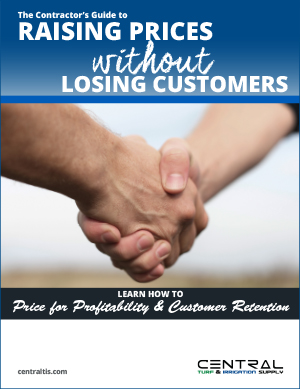As we’ve mentioned in previous articles, supply chains have been disrupted for nearly 75% of U.S companies, and our industry will continue to be impacted through 2021. We’re also seeing manufacturer price increases across all categories due to: increased transportation costs, government regulations, and raw material price increase on items like copper, resins/plastics, and urea/potash.
There are several ways you can overcome these challenges such as: understanding where the shortages are, planning and being strategic with purchases, working with a dedicated partner such as Central, and taking advantage of early order programs to guarantee products and lock in pricing. But what else can you do?
In 2021, we’re going to see a lot of the same business volume that we did in 2020. We’re still seeing trends of cocooning and a big focus on home improvements. With this increase in demand, now is a good time to consider raising your prices.
Below you will find 5 tips for raising your prices without losing customers:
1. Build Value
You’re not just another contractor doing the same thing as everyone else. You bring unique qualifications, credentials, and know-how to the project. Your team delivers outstanding service and quality work. Make sure to sell your value in your sales materials and your face-to-face presentations. Customers want you to be the expert. They are willing to pay more to work with a reliable and experienced professional.
2. Not Everyone Is A Price Buyer
In a typical market, only 30% of buyers have price at the top of their mind. The other 70% are significantly more interested in service, timing, and convenience. Price shoppers are the minority, not the majority. So, stop assuming you need to worry about the cost of your services with every customer. Customers call you because they want to buy something.
3. Know Your Price-Sensitive Customers
It’s important that you know what services are price sensitive in your market. For example, most consumers know prices of items they purchase often, like milk and bread. They use these products to determine if a store is expensive or not. Now think about birthday candles. Are they $2.99 or $6.99? Stores can charge high prices for birthday candles because most consumers have no idea how much they should cost. In your own business, think about the services where customers have low and high awareness, and raise prices accordingly.
4. Price For Your Business, Not Just One Customer
Don’t let one or two special customers derail the proper pricing for your business. Sometimes contractors hesitate to raise prices because they worry about the elderly customer on a fixed income or they’re afraid that a long-term customer will complain. Get your overall pricing right, and then make minor modifications for the special accounts. Take care of your loyalists, but don’t let them keep you from adjusting your overall plan when you need to.
5. Price Lock Ins
Using long-term contracts to lock-in prices may be a good strategy to when targeting specific segments of your customer list. If your business is driven by contracts that renew each season or you have a subset of customers that may not renew—this may be a good strategy for you. Be careful not to lock-in too low of rates or for too long, and only use this strategy with specific customers—especially with costs and inflation on the rise.
If you don’t have a copy, we have crated a pricing guide that includes these five tips as well as recommendations on communicating to your customers, and common mistakes business make when raising prices. Get the full guide here.
Finally, rely on Central to help, whether it’s questions about inventory management, strategic purchasing, marketing strategy, or business planning. We stay at the leading edge of the industry and we’re ready to help you grow!


